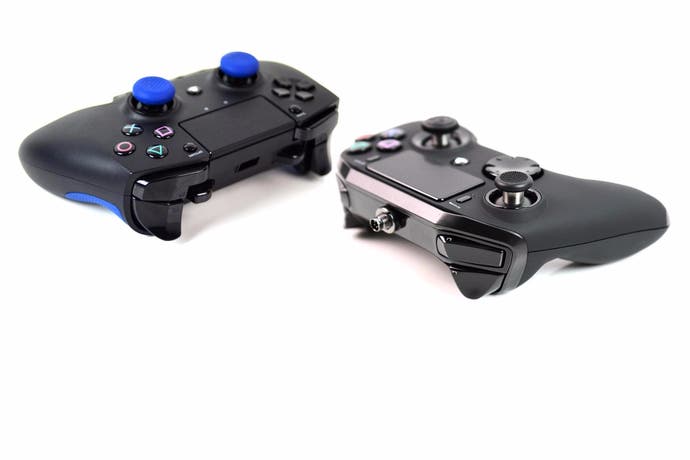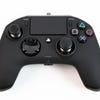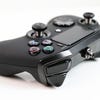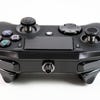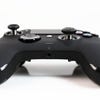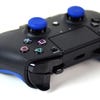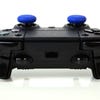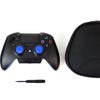PS4 premium joypad face-off: Razer Raiju vs Nacon Revolution Pro
Can an expensive controller make you a better gamer?
Few can argue that Sony's DualShock 4 is an excellent default controller for the PlayStation 4. It's served us well this generation, and that's perhaps just as well, bearing in mind the lack of third party alternatives. A couple of months ago, Sony began to loosen the shackles on its proprietary USB protocols and hopes were high that we'd see something similar to the Xbox One Elite pad - a controller with more accurate sticks, triggers, and massively improved build quality.
Unfortunately, Sony has yet to make such a controller itself but its solution is to give official licensing rights to two third party pads: the Nacon Revolution Pro, and the Razer Raiju. So just how much better are they than the standard DualShock 4 - and to what extent can they help to make you a better gamer?
Both the Razer Raiju and the Nacon Revolution Pro are wired solutions targeting the professional, or eSports gamer - with premium price-points to match: £80 for the Nacon Pro and a wallet-busting £150 for the Raiju. Factoring in these costs, it is a bit of a shame that neither works wirelessly at all. That's not the point of these controllers, but it will disappoint some that the functionality isn't there as an option, with both the Nacon and Raiju relying on a detachable braided USB cable for low latency control.
It's a no-nonsense approach, meant to give you the fastest trigger response in first-person shooters, for example. However, other regular DualShock 4 features are stripped out completely as well. There's no in-built battery obviously - everything is powered from the USB interface - but the light bar and integrated speaker are removed, the former meaning that neither of these pads are compatible with PlayStation VR. However, in their place, you get four extra customisable triggers on the back, to tweak however you like.
That's where the similarities end between the new controllers. Let's start with the Nacon Revolution Pro - the cheaper of the two. Right off the bat, the Nacon has a nice, velvety material in the hands, and adopts the Xbox arrangement for thumbsticks, which some may see as a bonus. One complaint here is the mould of the gamepad doesn't sit quite as comfortably in the hand as we'd like. It feels uneven, and overly bulky, especially compared to the slimmer profile of the DualShock 4. As a bonus though, you can adjust the weight of the controller using supplied miniature weights, added inside the hand grips. It's something even the Razer Raiju doesn't offer, and it's a welcome option.
Fortunately, the thumbsticks feel great. These are raised much higher than a regular PS4 pad, putting it more in line with the Xbox One's height. You get a 46 degree action on the tilt, which for FPS games like Battlefield 1 does make it easier to execute smaller, granular movements. Generally, it takes time to acclimatise to any new controller - a teething period, if you like - but the sticks here are worth putting the time into. They're more delicate, but with practice it's clearly a more accurate tool for aiming and strafing in FPS titles. It's fair to call this the strongest part of the Nacon hardware.
There's one unusual design choice however; each analogue stick uses completely different designs, mixing a concave, web-like texture for the left stick, and a convex one on the right. It's a matter of preference which you prefer, but unfortunately there is no hot-swapping between the two to fix the controller more towards your taste. These sticks are permanently fixed in place, and given a lack of customisation, we would have preferred uniformity instead.
Elsewhere on the controller, the Nacon starts falling short. For one, the trigger design is awkwardly shaped, with very rigid angles built into the glossy plastic. Likewise, the d-pad is built from a similar glossy material, a single block with very restrictive movement. It's a lot like the original Xbox controller's d-pad in fact, not the worst out there, but for fighting game enthusiasts it's a no-go. Rounding that off are the face buttons, which thankfully have a similar tactile feedback to the standard DualShock 4; they're oversized by comparison, but feel just as comfortable to use as the regular pad.
Clearly the Nacon Revolution Pro is geared towards the competitive FPS crowd, and the customisation elements are impressive. Unlike even the more expensive Razer Raiju, there are a multitude of ways to tweak the response from all inputs, using a free Windows program on Nacon's website. Just download the program, connect the controller to a PC, and from there you can tweak just about everything you could imagine.
This gives you four custom preset slots, and for each one you can essentially remap every button. On top of that, it lets you modify the response curve and dead zones on the sticks, the sensitivity of each trigger, the intensity of vibration, and even program a macro sequence to a single button press. This is really cool stuff - and once detached from a PC, all your settings are accessed with a switch on the back of the controller, cuein a change in LED colour on the right stick. All in all, the Nacon Revolution Pro has a lot of great ideas behind it. There's plenty to customise behind the scenes, the sticks feel great, though the d-pad and triggers are a step back from the regular DualShock 4.
At almost double the price meanwhile, you'd expect the Razer Raiju hand in something exceptional, a true leap in quality that does everything for everyone. The plus points first then: the Raiju feels much nicer in the hand. Ergonomically, this matches the Xbox One controller's mould, using a matte hard plastic that fits comfortably in the palm, with a rubber grip on the underside. You don't get the weight adjustments of the Nacon here, but it's suitably lightweight. And even with the extra control panel at the bottom, with buttons to change profiles, mute, and change volume, it doesn't feel overly bulky.
Looking a bit closer, it's clear that again, this is a controller tailor-made for the first-person shooter crowd. Anyone familiar with the DualShock 4's stick height and tilt resistance should feel right at home here at least; they feel very close, if a touch more sensitive, and come pre-equipped with two blue rubberized grips on top. These look cheap, to be frank, but under the thumbs they give a surprisingly satisfying, spongy feel.
For future-proofing such an expensive controller, it makes sense to have the area most prone to wear-and-tear to be replaceable. You wouldn't want to use the stick underneath either; taking these grips off, you're left with a slippery material. Another downside here is the steel stems of these sticks make a loud knocking sound when you hit the plastic rim. It's not as elegant as you'd expect, but with headphones you shouldn't notice. Overall, it's up for debate whether these are better or worse than the higher-profile Nacon sticks, but if you're familiar with the DualShock sticks, these will take less getting used to.
A big plus point for the Raiju are the triggers, a leap in quality over the Nacon's at least. These come with a hair-trigger mode that gives a shallow depression on each trigger, for short bursts in shooters. Simply pull the locks for each trigger at the back, and the trigger depression range goes from 18 degrees movement to five. This cuts off all velocities beyond that point, so it's a bad choice for racing games, or Rocket League, where you need that full range to accelerate properly. But it's a useful feature for quick fire games that need faster trigger presses, like Call of Duty.
Again, it's a sign the Raiju is mainly engineered for the best performance in FPS games, and that's how it goes for the rest of the controller. Every input is extremely sensitive, from the small micro-switch face buttons to the shoulder buttons. Even the lightest glance on these triggers an input. It's great for translating a finger press quickly to an on-screen action, but we had to be extra careful where we rested my fingers with games like Dark Souls 3. Another side-effect of using smaller switches is that the controller's heavy rumble can cause all the buttons to rattle. Again, it doesn't make it feel as premium as it should.
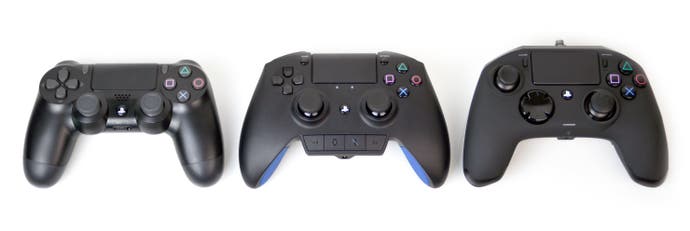
And then we get to the d-pad. Sadly, this is the worst d-pad we've used on PS4 controller to date, and even the Nacon's sub-optimal d-pad is better. There's really no skirting around the issue: buttons don't press down easily, and each element of the d-pad is an individual button, making quarter circle turns tricky games like Street Fighter. What we really wanted here is something in line with the Saturn d-pad, or even the Xbox One's version would have been better. As this stands, this is fine for quick selecting weapons in Call of Duty, but not ideal at all for moving characters in a 2D title.
It's surprising to see that the Raiju is also less customisable than the Nacon. You do at least get four extra assignable aluminium triggers, which feel great at the back, though two can be removed if they get in the way. These are assigned in a really intuitive way too. All you do is hold the assign button on the control panel, under the left analogue stick. Next, hold one of those four triggers, and then a controller button you want to copy. You'll feel a jolt of vibration to let you know that input is now mapped to the trigger. It's a more direct system than the Nacon for sure, with no PC software involved - however, it comes at the expense of flexibility to tweak anything else. At least, you have two custom modes to switch between, using a toggle right next to the assign button, but that's the extent of your options.
Overall, it's clear that a lot of work goes into the engineering of a great controller. The pros and cons of the Nacon and the Razer Raiju makes you realise just how much the regular DualShock 4 got right in the beginning, as a go-to controller for all games. In fact, between these two more expensive options you could create a great hybrid controller, one with the triggers and ergonomics of the Raiju and the customisation of the Nacon. However, individually it's hard to justify spending so much money when there's the sense that you're not getting the complete package.
So what we're left with are two controllers seemingly aimed at a very specific audience: the competitive FPS gamer. In this respect, the Nacon seems like the better buy, but we just couldn't get on with its very uncomfortable triggers. The Raiju comes out on top here in our opinion because the fundamentals, sticks and triggers, are fine - it's just a shame that the d-pad and face-buttons disappoint. And with that in mind, factoring in the Nacon's superior customisation options, we would recommend going hands-on with both pads before making a purchase.
Coming out of this testing, what's clear is that Sony's standard DualShock 4 remains an exceptionally good controller - and that it takes something seriously special to offer up a genuine leap. In this respect, we really need to emphasis just how good Microsoft's Xbox One Elite controller is - the hardware team did a phenomenal job there, but the wait continues to get a PlayStation 4 alternative that is its equal.
